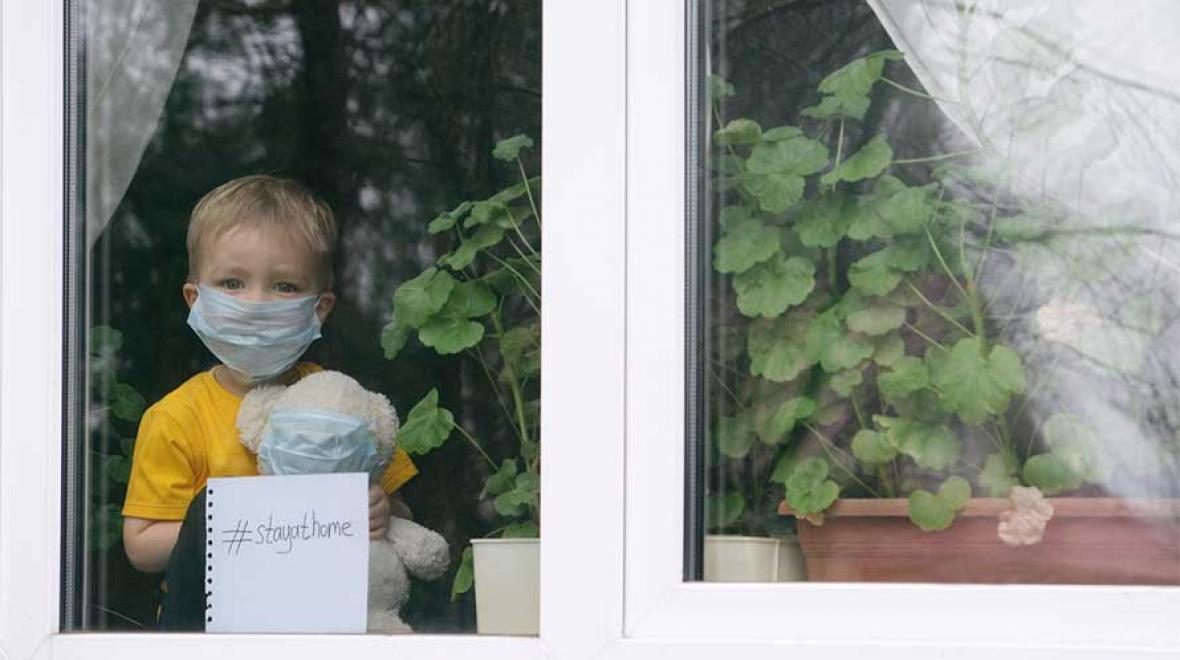
In recent years, thankfully, many of the myths about only children have been debunked: Turns out they’re not really more self-centered, spoiled or maladjusted than their counterparts in multi-kid families.
However, there is one incontrovertible fact about only kids that’s been laid bare by quarantine. There is only one of them. There is no one in the home to play with but adults. In normal life, that fact is often obscured by the regular flow of school, sports, activities, play dates, neighborhood interactions. Now, it’s as clear as the stricken look on my 10-year-old only kid’s face when we finally announced to him, a few days after school shut down, that everything was really, truly canceled.
Really? He asked. Not even a one-kid play date every now and then, where we promise not to get near each other?
No, honey. Really. Just us.
What does this mean? I’ve been reflecting on our situation ever since school ended, in between telecommuting to a communications job and trying to manage homeschool (I work from home; my husband still goes to his essential job). Raised by a single mom as the middle of a tight trio of sisters, I never intended to be “one and done,” but age and circumstance dictated otherwise.
The pandemic has brought a fresh ripple of grief.
And my son feels it. Though he’s an introvert who plays well by himself, he acutely misses social contact. He’s by turns frustrated, unmotivated and sad that the social element of school has been completely excised from his daily life.
So I reached out to a few other only-kid families to see how they were coping and connecting, especially as we look ahead to a summer that could be radically different than what we were expecting.
Screentime is literally saving us
When I asked my son what he would recommend for only kids to help them cope, he had two answers: A dog (we have a 5-year-old poodle terrier mix who’s never been happier) and video games.
A couple of weeks into quarantine, my son was doing more online gaming, video chatting and FaceTiming in a day than he had previously done in a week, or perhaps weeks. In some cases, it’s a multiplayer game; in some cases, he’ll play a single-player game (such as Zelda) while video chatting with a friend who’s playing on his own device. They’ll share screens and swap stories while making progress on their individual quests.
This trend is going only in one direction, up. And as long as some schoolwork, outdoor time and other activities are happening. I’m mostly okay with it.
Becky Snider, a mom who lives with her husband and 12-year-old son in the Snoqualmie Ridge area, has a similar approach. She encourages alternative activities — family bike rides, chores, projects — but doesn’t limit screens. “Right now everyone is emotionally stressed and I feel like if playing video games helps our son cope, that's okay with me, as long as he is also doing other things throughout the day.”
Snider has also taken advantage of their flexible schedule to enroll their son in Outschool, a web-based classroom platform, which she says “he loves and that helps him a great deal in feeling connected.”
Finding ways to pursue strong interests online can be a great outlet for certain kids. A 12-year-old in our circle is deep into a Zoom-based Dungeons and Dragons course. The group is small and focused. He has something to look forward to every week.
But video time doesn’t satisfy all social needs, especially for some children. I have a friend whose only son has been devastated by the loss of school, sports and playground time. He games, but it’s often a poor substitute.
8 cool things for kids to do on Zoom
Do your kids get on FaceTime with their friends and draw a blank? Here are a few ideas, beyond video games.
- Craft together: Get your favorite crafting supplies, set up the laptop, and paint or finger-knit together while chatting or being silent.
- Have a weekly comics group: If your child is more into writing or comics than crafting, do that. Kids can draw for 10 minutes in silence, then share.
- Board game: Certain games such as Battleship, Guess Who and Bingo lend themselves to Zoom calls. If it drifts into video game territory afterwards, so be it.
- Teach each other: A friend’s daughter recently taught her friends how to make chocolate mug cakes over Zoom. This idea could lend itself to all sorts of ideas.
- Build and compare: Work on a Lego structure, show each other, rinse and repeat.
- Appy connecting: Cariboo lets kids draw and read books together. Chess by Post is a slow-moving chess app; Words with Friends is great for Scrabble-loving kids.
- Watch a movie: Netflix Party is great, but the chat feature isn’t a fit for all kids. We’ve also had success with starting a movie at the same time and FaceTiming while watching.
- Come up with your own list: Generate a list of things to talk about and do before you get on the call.
Anchor activities help
While my child is decidedly uninterested in extra classes of any sort, we have had success with screen-based versions of everyday activities. For three weeks, he’s done a virtual weekend breakfast with a friend, another only, which has included Battleship, showing each other their Nerf guns, parallel video gaming and even periods of silence. For younger kids, of course, it can be harder to connect online. Jaclyn Shusterman, a Shoreline mom of a 3-year-old son, is feeling the loss of connections to extended family. “The variety of time around different people is important for kids - time with parents, other adults, kids of a variety of ages, etc. He's only getting this one type of in-person relationship now.” But she is grateful that her family has been doing their best to keep those bonds up. When her son calls relatives on FaceTime, they make time to talk with him. He's done a cousin movie night over Zoom. And a chemistry professor aunt has even done science projects with him over video chat.
The outdoors is everything
A quick glance outside tells the story of one of the silver linings of this experience: So many families are walking, biking and scootering together. After some bumps, my small family has a relatively ironclad routine of going somewhere outside almost every day. My son’s stamina for longer walks and bike rides is building. The benefits of this are so expansive that I almost don’t want to talk about it, for fear of jinxing. Yes, we get exercise and nature connection during this spring of all springs. But a “daily constitutional” — as I’ve seen one person call it — also connects us to real people in real interactions. When you’re a three-person family, those moments are golden. We run into classmates, younger neighbors and parents of friends and talk, six-feet apart, trying not to seem too eager. Or we spot strange things that give us stories for later — a car doing burnouts in a parking lot, a neighborhood “joy board,” a rookery of herons’ nests. And we talk to each other in new ways, a welcome break in a day that is otherwise riddled with power struggles over schoolwork and screentime.
Neighbor connection
Vanessa Tarantino is a Seattle mom to a 4-year-old who previously attended preschool several days a week. Like many parents of onlies, she’s worried that a long-term quarantine will affect her son’s social skills. While video calls and app-driven story time with preschool classmates and friends have helped, the occasional in-person chats with older adult neighbors are also lovely. “It’s slightly bittersweet to see his bids for attention and conversation with them and I'm so grateful for the interest and warmth they've shown him, willingly chatting about their gardening chores or inquiring about the books he's been reading,” she wrote to me in an email.
Let the feelings roll
Our surroundings might be unchanging, but the emotional terrain we’re collectively navigating has serious ups and downs. A sibling is no guarantee of a peer willing to listen. But it’s at least a possibility.
Marisol Hanley, a Seattle psychologist and mother to an 11-year-old only daughter, is navigating a newly remote practice while her research scientist husband still goes to his lab. In between sessions with stressed-out clients, she helps her extroverted daughter connect to friends, do schoolwork and process her emotions around the changes.
There have been many hard moments, such as the announcement that schools had closed for the rest of the year. Meltdowns have come in waves. “We had to just wait it out,” says Hanley. “If I had just gotten mad and impatient, it would have made it worse.”
A “we’re in it together” approach also helps. “We have more success when we can approach things like we’re a family unit,” she says.
One sign of maturity: Her daughter recently initiated a family meeting to say her piece about how she wanted things to go in the house.
Compassion instead of comparisons
Monica Cagayat, a Kenmore mother to a 3-year-old only girl, brought up an unexpected silver lining of isolation with an only that had not occurred to me before.
Although her family has been challenged by many things during quarantine, Cagayat, who works as a marriage and family therapist, has appreciated the opportunity to spend extra time with her daughter, who’s usually in day care.
“I've been really encouraged by noticing all the ways my daughter continues to make strides in her language, and in learning new things developmentally,” she says. “It's such a great time to notice this because there are no other kids to compare to! Instead, it's all her. I love that.”
I love that, too. I have noticed that for all types of families, social media brags — expect for the occasional bread-baking triumph — are toned down. No one’s doing 10-mile hikes with their kids or winning soccer trophies. Instead, parents are commiserating over homeschooling failures, how hard this is, and — at the end of the day — how lucky many of us are to be able to huddle with our families, big or small, together.











